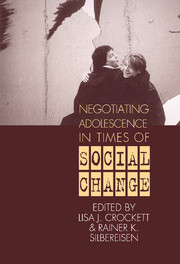Book contents
- Frontmatter
- Contents
- Contributors
- Preface
- 1 Social Change and Adolescent Development: Issues and Challenges
- Part I Models of Social Change Effects
- 2 Surmounting Life's Disadvantage
- 3 Marriage and the Baby Carriage: Historical Change and Intergenerational Continuity in Early Parenthood
- 4 Effects of Social Change on Individual Development: The Role of Social and Personal Factors and the Timing of Events
- Part II Social Change and Adolescent Transitions
- Part III Social Change and Adolescents' Social Contexts
- Part IV Implications of Social Change for Adolescent Health and Well-Being
- Part V Interventions: Promoting Healthy Development in Times of Social Change
- Endnotes
- Index
3 - Marriage and the Baby Carriage: Historical Change and Intergenerational Continuity in Early Parenthood
Published online by Cambridge University Press: 26 January 2010
- Frontmatter
- Contents
- Contributors
- Preface
- 1 Social Change and Adolescent Development: Issues and Challenges
- Part I Models of Social Change Effects
- 2 Surmounting Life's Disadvantage
- 3 Marriage and the Baby Carriage: Historical Change and Intergenerational Continuity in Early Parenthood
- 4 Effects of Social Change on Individual Development: The Role of Social and Personal Factors and the Timing of Events
- Part II Social Change and Adolescent Transitions
- Part III Social Change and Adolescents' Social Contexts
- Part IV Implications of Social Change for Adolescent Health and Well-Being
- Part V Interventions: Promoting Healthy Development in Times of Social Change
- Endnotes
- Index
Summary
Susie and Johnny sitting in a tree
K. I. S. S. I. N. G.
First comes love, then comes marriage
Then comes Susie with a baby carriage
(American jump rope rhyme)
Women have always become mothers during their teenage years. However, in most industrialized countries, marriage preceded the baby carriage. Few births to young women occurred in the absence of marriage. Even when an unmarried girl became pregnant, societal norms and parental sanctions usually resulted in a hasty marriage (what was termed a shotgun marriage because the man who got a young woman pregnant was forced to marry her). Consequently, when a young woman did become pregnant, marriage would precede (by a few months) or quickly follow the child' birth. The rhyme quoted above that young girls in the United States chant when jumping rope was almost a universal fact of life.
Over the past 40 years a dramatic change in the context of teenage childbearing has occurred. In 1960, 40% of girls were married by the age of 19 compared with 15% in 1986. In 1960, 15% of all teenage births were to unmarried girls. In 1995, 75% of teenage births occurred out of wedlock (Ventura, Martin, Curtin, & Matthews, 1997). An examination of the rates of unwed teenage births across different ethnicity and race categories in 1995 has revealed that, for Blacks, the rate was 95%, whereas it was 68% for Whites and 67% for Latinos. Thus, the context of teenage childbearing has shifted from marital to nonmarital. At the same time, marriage and childbearing ages have increased over the past two decades for middle-class youth, although not for poorer youth (Cherlin, 1992; Rosenheim & Testa, 1992).
- Type
- Chapter
- Information
- Negotiating Adolescence in Times of Social Change , pp. 36 - 57Publisher: Cambridge University PressPrint publication year: 1999
- 1
- Cited by



